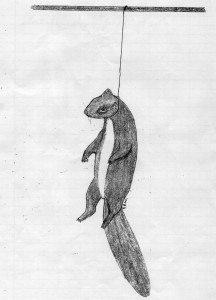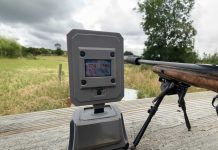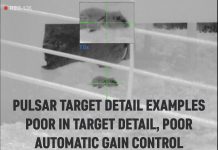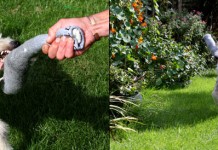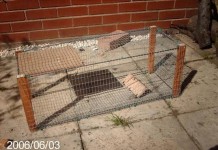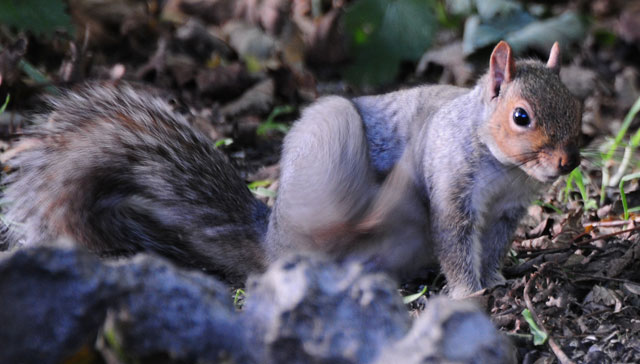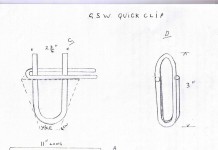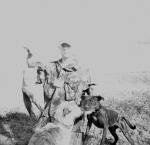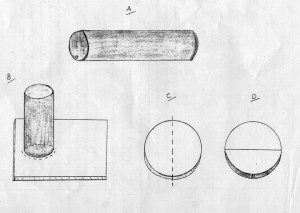
A. This is a small length of grey plastic pipe, four inches in diameter, 12 inches long. There is no hard and fast rule as to the length it is only a simple bait station as an attraction to draw grey squirrels to feed at the pipe. Securing hole seen at mouth of the pipe.
B. Showing vertical pipe on top of a piece of square plywood half an inch thick, draw around and cut circular piece of wood out.
C. Cut the round biscuits in half.
D. Place the half biscuits in either end of the pipe about ½” in from the mouth of the pipe, then insert two small screws through the opposite side walls of the pipe to hold half biscuits securely in place, now insert a screw into the ½” space in front of the biscuits to secure pipe to the pole.Squirrel Bait Station On Pole Squirrel Bait Station On Pole
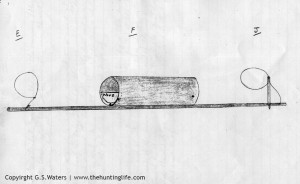
E. Shows a single simple snare loop secured to a nail at the side of the pole, the end of the snare cable can also be wound around the pole itself, firmly but not over tight, so that when a catch is made, the snare slides around the pole and the squirrel drops off.
F. Pipe is attached permanently to the running pole, hazel,larch, silver birch or willow, etc can be cut for running poles.
J. The snare loop is supported in position by a little hazel or willow tealer pin, which has been pointed at the bottom and inserted into a small staple driven into the side of the running pole, the end of the snare is attached to a nail at the side of the staple, just half hitch the end of the snare loop to nail, same as attaching rabbit snare to a fenceline.Bait Station & Snares In Place
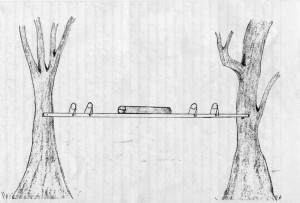
Running pole attached between two trees, simply by hammering a nail through one end of the pole and resting the pole on the nail at the opposite end, this allows the pole to be lowered to ground at one end. The pipe is filled with grain to the level of he half biscuits, which stops the contents from spilling out of pipe.
The snare system seen here is the wire loop snare method, same as snaring rabbits and hares, only difference being that the hoops are stapled to the sides of the running pole and are permanently attached, snare loops are hitched on hoops, same as a rabbit snare, this can be set and removed in seconds. The snares can be attached to the wire hoops but not set in positin to catch, let the grey squirrels get used to coming to the bait station and they become quite bold and hide in the pipe, they will squabble with each other, sometimes there can be upto a dozen at a time present. Pest controllers can setup many bait stations throughout large woodland area’s, set around four snares on each pole, keep them back from bait pipe and keep the snares apart also, set around 4 1/2″ high to the bottom of the snare loop. With around 30 bait stations you can take a hundred squirrels in a morning, check them twice a day. Running poles can be placed around pheasant feeding area’s even without bait stations, you can also lean a pole from a tree, down to a pheasant feeder, set a snare loop on it, same angle so the pole, remember to catch going up or down, use a 4 strand rabbit snare, or two strands of stainless steel wire the same diameter as the brass rabbit snare wire.
This simple system is very cheap and cost effective method of controlling grey squirrels, keepers can be catching them on a regular basis, while going about their daily work.
Thin weather snares are hard to see and are very effective in the proper hands, if you lose a snare to theft you are a couple of pennies short, if you lose a trap its around £6-£9 a time.
There are other components that can be utilised for bait stations on running poles, such as square or round plastic tree guards, or plastic litre coke bottles, square water bottles, empty milk cartons, once the contents have been consumed, use any container and cut off only the top parts at each end of the bottles, so the grain doesn’t spill out.
Regardless of what type of container you use for a bait set, it can be sprayed lightly with green paint or brown, just to help blend into the woodland surrounding. The grey squirrel has become a serious little pest in the british woodlands causing a lot of damage to our mature hardwoods, robbing eggs from birds nests and eating the chicks, the government also want them controlled. Don’t use snares where the native red squirrel is present, use cage traps only, to attach plastic bottles to a pole push a length of thin wire through the lower sides or aroundbottle and twist tightly under the running pole.
End Result Snared Squirrel
